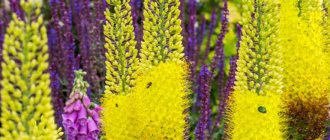It is very useful to grow calendula (marigold) in your garden. These cute bright flowers will not only decorate your flower beds, but will also repel pests. In addition, marigold flowers can be collected, dried, brewed and used as a bactericidal or anti-inflammatory agent. Growing calendula flowers from seeds is not difficult. We described in our article how to properly and when to plant seedlings in open ground in spring, summer, before winter and how to care for marigolds in the garden step by step with photos.
What does a calendula flower look like: description with photo
Since the 16th century, the calendula flower has been decorating gardens. The plant, up to 70 cm high, has elongated, lanceolate or oval leaves, pubescent stems and yellow or orange petals. The inner tubular and pseudolingular flowers of marigolds may be darker in color. Calendula begins to bloom in June and continues until the cold weather. Back in October, if there is no severe frost, you can see bright spots of marigold flowers among the gray grass in the area.
Types of annual plants planted before winter
As already mentioned, in winter you can plant both annual and perennial plants. The annual species include the following:
Latest articles about gardening
- Chinese carnation
- Chinese aster
- Delphinium of Ajax
- Godetia grandiflora
- Iberis bitter
- Calendula
- Snapdragon
- Poppy self-seeding
- Mignonette fragrant
- Phlox Drummond
- Chrysanthemum
Of course, these are not all types of flowers that can be planted in winter, but they are the most common annuals.
When to plant calendula for seedlings and in the ground according to the timing and the Lunar calendar
To obtain early flowering, calendula seeds are sown on seedlings in March - April. You can plant directly in open ground only after the soil has warmed up at the end of April or May (depending on the climate of the region).
After sowing in the ground in spring, flowering will occur in the second half of summer. Therefore, many gardeners practice planting calendula in the fall before winter in October or November. In this case, entrances will appear in early spring, and the marigolds will begin to bloom in June-July.
Find out how and when to sow flower seeds before winter by clicking on the link.
According to the Lunar calendar in 2022, favorable days for sowing calendula for seedlings and open ground:
- 3, from 11 to 13, 16, 17, from 21 to 26, 29, 30 March;
- 8, 9, 13, 14, from 17 to 22, 25, 26, 27 April;
- 5, 6, 7, 10, 11, 14, 15, from 17 to 20, 23, 24, from 27 to 29 May;
- from 1 to 3, 6, 7, 11, 12, 13, 15, 16, 19, 20, 24, 25, 30 June;
- July 4, 5, 8 to 12, 17, 18, 21, 22, 26, 27;
- 1, from 4 to 10, 13, 14, 17, 18, 22, 23, 28 August;
- from 1 to 6, 9, 11, 13, 14, 15, 19, 20, 24, 25, 28, 29, 30 September;
- 1, 2, 7, 8, 11, 12, 16, 17, from 27 to 30 October;
- November 3, 4, 7, 13, 14, 15, 19, 20, 24, 26, 27.
You will be interested to know: Pre-winter sowing of lavender: step-by-step instructions for planting seeds before winter
Throughout the summer, you can sow marigold flower seeds in open ground. They will bloom closer to autumn, reproduce by self-sowing and sprout next year in the spring.
Please note that hybrids do not reproduce in this way. This applies only to simple varieties.
Calendula care
If you ask a gardener what unpretentious flower remains decorative all summer, you will hear the answer - calendula: growing in comfortable conditions guarantees flowering from June until frost.
Feeding and watering
It is necessary to water the bushes regularly, but so that the water does not stagnate in the soil. When watering in the evening, you can irrigate all the bushes with water. But when watering during the day, this is done carefully, so that water does not get on the leaves and inflorescences.
For feeding, drugs such as Kemira, Plantofol or Fertika are usually used.
Reproduction
Marigolds are grown only from seeds. But this is enough for them to take root in their areas. At the end of each flowering season, the flower disperses its grains. Some of them survive the winter and emerge the next year.
Trimming
Plant pruning is widely used in the care process. Dried leaves and buds that have stopped blooming are cut off. But you can also take extreme measures: when most of the stems have already faded, cut all the bushes to about 20-25 cm from ground level. Stress will activate additional reserves in the shoots, and this will lead to repeated flowering.
Wintering
For the most part, marigolds are annual plants and do not need to overwinter. The resistance of grains and sprouts to cold climates allows the flower to effectively self-sow in the same area for many years.
Sowing and growing calendula seedlings step by step with photos
For seedlings, marigold seeds are planted in deep plastic containers with drainage holes, boxes or individual pots. The containers are filled with moist flower soil.
The seeds are buried 2 cm into the ground, sprinkled with soil on top, sprayed with warm water from a spray bottle and covered with cling film or cellophane. Crops are placed in a warm place with an air temperature of +20 degrees.
Every day, the film will need to be removed for a few minutes to ventilate the substrate and check its humidity. As soon as the top layer of soil begins to dry out, it will need to be sprayed with water at room temperature.
In about a week, seedlings will begin to appear, which will need to be moved to a well-lit, cool place with an air temperature within +15 degrees.
Caring for calendula seedlings includes:
- Timely moistening of the soil. It is not recommended to over-moisten the soil, as plants may be affected by blackleg.
- Fertilize once every 7-10 days with mineral fertilizers, the concentration of which should be approximately two times less than what is written in the instructions.
- It is necessary to pick marigold seedlings after two true leaves appear on the plants. They are planted in disposable cups or peat pots and flower soil is used. After picking, the plants are watered and placed in the shade for 2-3 days, where the sun's rays do not reach.
If calendula was grown to decorate a balcony, then when picked, it can be immediately planted in flowerpots, balcony boxes or pots.
You will be interested to know: When and how to plant fragrant tobacco seedlings, planting and care in open ground, step by step with photos and videos
How to grow seedlings and care for them
This method is used when they want to get early flowering. Growing calendula through seedlings is also used for low-growing varieties.
At the very end of March and beginning of April, the seeds are sown in a box filled with soil mixture for flowers. The sowing depth should be no more than 2 cm. The container with the seeds must be covered with film.
The most favorable temperature for growing seedlings is 18–20 degrees. The room where calendula is grown should be bright, but protected from the sun.
The film is removed when the first shoots appear. This happens in a week. The temperature is reduced to 14–15 degrees. Every two weeks the seedlings are fed with complex fertilizers. The solution is made weak. Water the calendula as the soil dries.
Seedlings are planted in plastic cups when they have two pairs of true leaves.
Planting seedlings in a flower bed
Having grown seedlings, it’s time to figure out when to plant calendula in open ground? This should be done after the bushes have grown, become stronger and have 5-6 true leaves. Marigolds are cold-resistant and can withstand light night frosts, so already around mid-May, after hardening procedures, they can be planted in flower beds.
For calendula, a sunny area is chosen, since only in the sun will the flowers bloom all the time, and in the shade they close. The seedlings are planted in fertile soil according to the pattern 30-40x20-25 cm.
If the seeds for seedlings were planted at the end of March, then at the beginning of June orange or yellow calendula flowers will form and begin to bloom.
Varieties and types of calendula
In terms of height, calendula can be short (up to 30 cm), medium tall (up to 45 cm) and tall (up to 85 cm).
There are also decorative and medicinal varieties, and there are also cut varieties. According to their shape, they are divided into gerbera, chrysanthemum and so on. But in general, all varieties are, in general, similar. Color ranges from light yellow to bright yellow and orange. Some varieties have white veins on the petals. The middle can also be different - for example, yellow or brown. The shape of the petals also varies. I forgot about the main thing: calendula flowers can be simple or double. Among the terry varieties, the following varieties can be distinguished:
- Golden ball (golden yellow and very “fluffy”) ,
- Sensation (orange),
- Favorite (pale yellow and with white stripes) ,
- Hamlet and others.
Among the simple ones: Medallion , Princesses and others. There are both domestic and foreign varieties.
Planting calendula seeds in the ground
In October or spring, when the soil in the garden warms up, calendula seeds can be sown directly into open ground. If you plan to sow in the spring, then it is recommended to prepare the bed or flowerbed in the fall by digging it up and fertilizing it with potassium, phosphorus and humus. Two weeks before spring planting, nitrogen fertilizers are applied to the soil.
Sowing marigold seeds is carried out in grooves, the distance between which should be 30-40 cm. The seeds are placed at a distance of 25-30 cm, to a depth of 2 cm. If calendula is grown to obtain medicinal raw materials, then it can be planted with a smaller distance between in rows (about 20-25 cm).
Marigolds tolerate transplantation well, so you can sow them thickly, and when the seedlings sprout and grow, transplant them to another flowerbed or to a bed between vegetables. About one and a half to two months after sowing, calendula will bloom and decorate the garden with its bright buds.
Technology of pre-winter sowing of flowers before winter
We’ve sorted out what flowers to plant before winter, now it’s worth talking about how to do it. If there should be no problems with planting perennials that reproduce by bulbs or roots - these flowers should be planted in the same way as in the spring, then sowing seeds in the cold autumn soil causes a lot of controversy.
Sowing seeds of annuals and perennials is not that difficult. In general, the technology is almost no different from that used in the spring. So, to begin with, it is recommended to carefully prepare the soil - dig it up with a shovel, removing the roots of weeds and other unnecessary inclusions. In the formed beds, already in September or even in August, you need to make grooves in which the seeds will be laid out:
- about 5-7 mm deep - for small seeds;
- depth from 10 to 15 mm - for medium-sized seeds;
- up to 50 mm deep - for large seeds.
During or before digging, it is worth thinking about the layout of the future flower garden, because seeds planted for the winter will sprout with the onset of spring, and replanting them from place to place will be very problematic.
Garden care
There is nothing difficult in caring for marigolds in the open ground and on the balcony. Growing calendula in the garden is very easy. To do this, it is enough to water, weed and loosen the plantings in a timely manner. Once a month, it is recommended to feed the flowers with fertilizers for flowering plants, which are low in nitrogen.
You will be interested to know: When and how to plant begonia tubers in a pot for germination
In order for marigolds to bloom until late autumn, their fully opened flowers must be picked off. That is, it is recommended to pick the inflorescences after the reed flowers of the baskets have assumed a horizontal position. If they are removed in a timely manner, the flowering will be very abundant and long-lasting.
Since calendula repels many insects, only aphids can attack it. When this insect is detected, the plantings are treated with Aktelik, Karbofos, Fufanon or another insecticide.
That's all for caring for calendula in the garden. In the fall, all that remains is to remove and burn the remains of faded plants, and dig up the flowerbed.
Add a comment Cancel reply
You must be logged in to post a comment.
Have you already finished the summer season, having “mothballed” your house for the winter and saying goodbye to your plants until spring? There is a reason to visit the dacha again, because you didn’t sow flowers before winter! This process will bring little trouble, and in the spring you will thank yourself for your foresight. After all, annual and perennial flowers sown before winter are practically free flower seedlings, which will also bloom two weeks earlier. We will tell you in this publication what flowers you can sow before winter.
When and how to collect marigold seeds
In order to plant your calendula seeds next year, it is important not to miss their ripening. If you are late in collecting planting material, the seeds will fall on the ground and you will end up with calendula self-seeding. To prevent this from happening, a gauze bag is placed on the selected flower, into which the ripened seeds will fall.
There are a large number of varieties, among which you can always choose bright sunny calendula flowers for growing on your plot. Moreover, planting and caring for calendula is quite simple, and even a novice gardener can cope with them. Don’t be upset if you don’t have a summer cottage; calendula grows well in the summer on the balcony and at home.
Types of perennial plants planted before winter
The list of perennials for winter planting is no less wide than annuals. The following perennials can be planted with seeds for the winter:
- Aquilegia;
- Rudbeckia;
- Primrose;
- Daisy;
- Alpine and New Belgian asters;
- Heuchera;
- Gypsophila;
- Spurge;
- Buzulnik and many others.
Pests and diseases
If agrotechnical practices , calendula can withstand attacks from pests and diseases. Leaves and stems may rot if plants are planted densely, the soil is too wet, or the weather is cold.
Signs of calendula being affected by powdery mildew
To combat diseases, use the drug “Fitosporin” or other fungicides. Insecticides are used for pests such as aphids and wireworms.
Bright calendula flowers go well with blue or purple flowers . Housewives often sow them along the fence, between plantings. The smell of calendula repels pests, including the Colorado potato beetle.
Growing rules
It is better to plant the plant in a illuminated area of the garden . Then the flowers grow larger and brighter. In the shade, the stem stretches and lies down. Calendula can withstand short frosts in spring and autumn down to -5 degrees .
Monochrome planting with calendula
Marigolds can grow on unkempt soil , but on fertile soil, especially varietal calendulas show their qualities more clearly and fully.
Preparation of planting material
Seeds for sowing can be obtained in a variety of ways:
Ask your neighbors in your summer cottage, and most likely you will receive them with detailed instructions for growing and caring for them.
Choose a variety on the Internet and buy it in an online store, or in any specialized store in your city. If you can buy seeds in a regular store, it is better to use this option. To order seeds online, personal recommendations from an online store will not hurt.
Collect the seeds from the plant yourself if you are already growing them.
It's fun to experiment with marigolds: mix different varieties and observe the results of cross-pollination, collect seeds and get a variety of plants each next generation.
After everything is determined with the choice of seeds, you need to sift them. Of all the grains that you have, you need to choose dummies and the smallest seeds. You can sit and select seeds with tweezers, or you can use a faster method - pour all the seeds into a water-salt solution, and all the debris will float to the surface, while the good seeds will remain at the bottom.
Traditional methods of soaking seeds before sowing
Folk methods for pre-sowing seed soaking are very diverse and are mainly aimed at reducing the germination time of seeds. We will list the most popular and, according to gardeners, the most effective.
Honey solution
Dissolve 1 tsp in a glass of warm water. honey Place the seeds in the solution for about a day. Afterwards, rinse thoroughly and dry.
Ash solution
Dilute wood ash (2 tbsp) in 1 liter of warm water and leave to infuse for 2-4 days. Then strain and place vegetable seeds in the solution for 3-6 hours.
Some gardeners add other ingredients to the ash to increase its effectiveness. Here is one of these “recipes”.
Add to a half-liter jar of warm water:
- 1 tsp wood ash,
- 1 tsp honey,
- 1 tsp alcohol tincture of propolis.
Mix all the ingredients thoroughly, and then place the bag of seeds in the solution for 2-4 hours.
Aloe juice
Aloe (agave), a well-known folk healer, not only increases the speed and percentage of seed germination, but also disinfects them at the same time. For the procedure, use the lower leaves from a plant that is more than 3 years old.
Wrap the cut leaves in a dark cloth and put them in the refrigerator for a week. After this, grind and squeeze out the juice using several layers of gauze.
Place slightly warmed seeds (place them on the radiator before soaking) in aloe juice for about a day. For tomatoes, 18 hours is enough.
If the seeds are fresh, then you can use not pure juice, but its aqueous solution: take 1 part water for 1 part juice.
Soaking in aloe juice is not recommended for onions, as well as for celery, pumpkin and pepper seeds.
Mushroom broth
Pour boiling water over the dried mushrooms and leave to steep until the water cools completely. Then drain the liquid and place vegetable seeds in it for 6 hours.
Mumiyo
Dissolve a small piece of mumiyo the size of a buckwheat grain in 0.25-0.5 liters of water. Place a bag of seeds in the solution and leave for a day.











